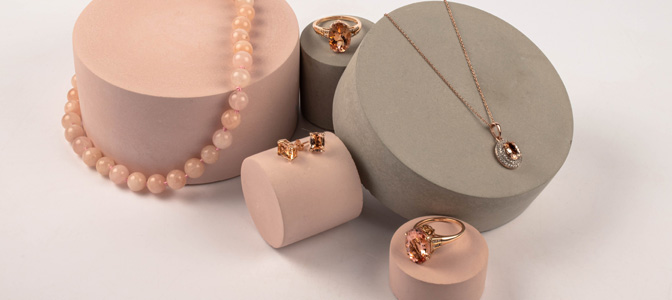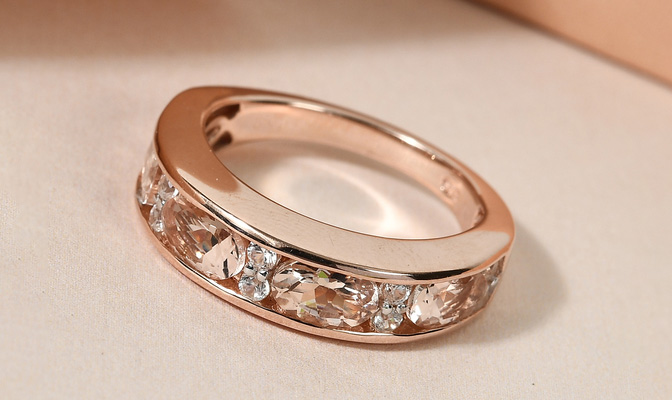Morganite Gemstone
Morganite is loved for its feminine colour palette and its strong connection with love and relationships.
SHOP MORGANITE
Introduction
Believed to be a stone of romance, Morganite is loved for its feminine colour palette and its strong connection with love and relationships. The gemstone is believed to be the best and meaningful stone that can be gifted to your partner with great pride. You may find the gem in various regions, but Morganite from Marropino happens to be the most dominating one.
Use and Effects
Beryl is believed/trusted to be a stone of perfection, ensuring safe travels. The stone is also thought to enhance the feelings of love and strengthen marriages. Out of all the varieties of Beryl, Morganite is believed to be exceptionally strong in that regard. The gemstone enhances one's charisma and is also useful for improving your appeal to potential romantic partners.
Morganite: A Birthstone or Not?
We cannot claim it to be a birthstone, but many prefer this pink beryl as an alternative to other beryl birthstones like Emerald for May borns or Aquamarine for March.
New Arrivals in Morganite

Popular Trends
Though the gemstone is widely available in multiple standard cuts and sizes, the stone is believed to have a special relationship with rose gold. Levelling up its reputation of feminine beauty, rose gold is found to be a popular choice for this gem. The delicate pastels of the gemstone are highlighted by the rosy pink metal, making these hues more pronounced. It is also a popular choice for delicate jewellery and many pieces of it favour a minimal design that primarily combines the pink beryl with rose gold.
A coloured stone engagement ring is quite preferred today wherein sapphire, and diamond rings top the charts. New brides are happily embracing the beauty of this feminine gemstone. Fancy cuts have taken over the traditional brilliant cut. Pear cut and longer stones in the east-west setting such as oval or marquise remain the two popular styles.
Though Morganite is quite preferred in engagement jewellery these days, it is still not commonly gifted as an anniversary gift.
It just isn't as vividly known in jewellery circles as other types of beryls, such as emerald or aquamarine. Some might prefer considering this rarer stone as an alternative to these traditional anniversary gifts.

How Does Marropino Morganite Compare to Various Other Pink Coloured Stones?
Pink is a pretty dominant colour, and we often associate pink with absolute womanly energy. When we contrast the peachy and pink hues of this beautiful gemstone to various other pink gems, what should we look forward to?
It shows a lighter pink tone than various other popular pink gemstones, like pink sapphire. Where the pink hue of the sapphire is often bright, vivid and intense, Pink Morganite is Somber and precise. You can always choose the pink variety for making a statement in conservative environments where the boldness of brighter stones might simply not work.
Softer hued gemstones, like Kunzite, often display a similar showcasing of colour. Nevertheless, the pink hues of Kunzite also come with components of violet and purple and make themselves differ from Morganite. These stones play pretty well together, and you're utterly safe while picking it where you might instead think of considering kunzite jewellery.
Pink diamond and Pink Morganite are pretty close to matching one another. Both the gemstones depict delicate and soft rosy hues. The colour of a pink diamond is natural, whereas the pink of this gemstone is commonly achieved through the treatment of the raw stone. Some may prefer the note that goes with knowing their jewel is entirely natural and choose a pink diamond. However, only these will occur in larger sizes, as nature limits the scope of pink diamonds when it comes to their size obtained from Argyle, Australia.

Features of the Morganite
The value of this alluring gemstone is determined the same way as that of any other coloured gemstone. Colour, Cut, Clarity and Carat weight play a huge role in determining the value of this gemstone.
- Colour: The beautiful gemstone is offered in a variety of beautiful shades ranging from tender pink to peach to salmon with little variations in between. Majorly, the stone displays light to medium saturation of hues, while larger gems display a greater depth of colour. The darker stones are a rarity because of their rare practicality in use. Pink happens to be the most common and desirable colour in the Morganite, but many sellers believe deep magenta as the most valuable. Many sellers prize untreated Morganite of a peach tone as they're rarely available for sale.
- Cut: The gorgeous gemstone features all types of cuts, be it the traditional ones or the fancy ones. The pleochroic nature and saturation of colour are the primary challenges faced by the lapidary while shaping the gemstone.
- Clarity: The beautiful gemstone is eye clean. Hardly any inclusion is visible to the naked eyes. If the additions are present in the polished stones, they'd be hidden when the stone is set. By any chance, if the inclusions are visible, the value of the gemstone would lower down automatically.
- Carat: You may rarely see Morganite compared with any other gemstone; there is a massive difference in price per carat for a larger stone than size alone. It is believed that peachy coloured stones that are untreated do not have a broad market. Compared to the pink ones, the demand for the peachy stones is relatively very less. At TJC, you may rarely come across stones of 5.5 carats, as usually, the stones available are of 4mm by 4mm to 12mm by 12mm.
- Treatment: To enhance the beauty or durability, most stones undergo treatment. In case of Morganite, the stone usually undergoes annealing (a type of heat treatment). In addition to this, the stone undergoes irradiation. Doing this together improves the colour of the gems, removes the peach and salmon tints and produces pinker stones instead. The treatment has decent stability and is permanent with proper gemstone care.
Care: To enhance the beauty or durability, most stones undergo treatment. In case of Morganite, the stone usually undergoes annealing (a type of heat treatment). In addition to this, the stone undergoes irradiation. Doing this together improves the colour of the gems, removes the peach and salmon tints and produces pinker stones instead. The treatment has decent stability and is permanent with proper gemstone care.
Cleaning with a simple solution of mild dishwashing liquid soaps, lukewarm water and a soft-bristled brush is believed to be the best way of cleaning Morganite jewellery. All you need to do is scrub it gently with the mixture until it looks clean and then rinse it with clean water. A soft lint-free cloth can be used to dry the jewellery pieces.
Steam Cleaners and Ultrasonics are also safe for it, but it is advisable to avoid them if the gemstones are highly included. The colour of your gem might fade due to prolonged exposure to heat and light. You should avoid exposing your jewellery pieces to harsh chemicals like everyday household cleaners.
A lined jewellery box is an excellent way to store Morganite Jewellery. To prevent accidental damage, keep your stone pieces of jewellery away from various other items in your collection. Wrapping the jewellery in a soft cloth and keeping it in a safer place away from light or heat when not wearing is also a secure way.

Sourcing
Morganite was primarily discovered in Madagascar in the year 1910. Following that, it has been found in Afghanistan, Mozambique, Myanmar, Namibia, Pakistan, and the United States. Although the best quality is obtained from the Marropino Mine of Mozambique. Unfortunately, despite a high hungry market for this gem, the occasional production keeps it from entering the mainstream.
Marropino also homes large deposits of Tantalum, an instrumental metal utilized in various commercial applications, from turbines to transistors. Morganite and Tantalum both occur in the same pegmatite rocks that are found dispersed throughout the mining place. As the market increases and decreases for Tantalum, this impacts operations to recover this gem.
Much of it is recovered as the result of large-scale operations. However, the lack of availability of infrastructure further entangles the mining in that area. Attempts from primary operations are addressing the issue, but progress can be a little slow. Artisanal miners also set off in that area, regain both Tantalum and Morganite, in addition to various other minerals. Many small-scale miners are seasonal/occasional workers who use mining as a means to generate an income as opposed to farming or other trade.








































